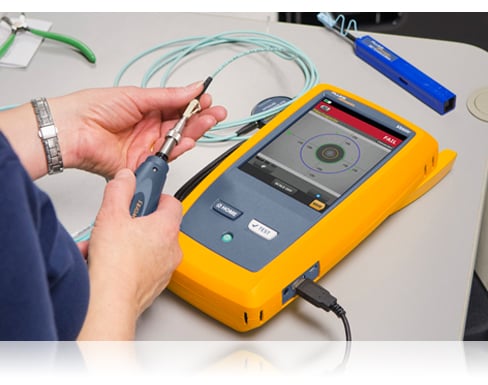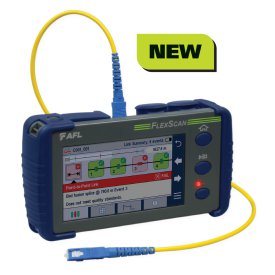A comprehensive guide to robotic vision in industrial automation
Wiki Article
Recognizing How an Optical Measurement System Enhances Accuracy in Industrial Applications
Optical measurement systems play an essential function in boosting precision across different commercial applications. By leveraging innovative technologies such as laser interferometry and 3D imaging sensing units, these systems supply high-resolution, non-contact dimensions. This capacity lessens the risk of damaging delicate parts while guaranteeing accuracy. The impact of these systems extends past simple measurements. Discovering their benefits, applications, and future patterns exposes a complex landscape of innovation and challenges that benefits better exam.The Fundamentals of Optical Measurement Systems
Optical measurement systems serve as essential devices in different industrial applications, offering specific data collection and evaluation. These systems use light as a primary methods of measurement, leveraging optical principles to examine dimensions, settings, and surface area features of objects. They integrate parts such as lasers, video cameras, and sensors, which function together to catch high-resolution images and information.The technology allows non-contact measurements, decreasing the risk of damaging delicate parts. Optical measurement systems are functional, finding utility in quality control, assembly verification, and dimensional evaluation throughout different markets. They are especially efficient in settings where conventional measurement techniques may fall short, such as determining intricate geometries or observing quick movements.
As markets proceed to develop, the combination of optical measurement systems will certainly remain crucial for making sure precision and efficiency, ultimately enhancing product quality and operational efficiency in different making processes.
Trick Technologies Behind Optical Measurement
Trick technologies such as laser interferometry methods and 3D imaging sensing units play an essential duty in the effectiveness of optical measurement systems (optical fibre diameter analyser). These modern technologies make it possible for exact measurements and comprehensive analysis in different commercial applications. Recognizing their capabilities is important for utilizing the full capacity of optical measurement systemsLaser Interferometry Techniques
Many laser interferometry techniques have changed the field of optical measurement, providing extraordinary precision and precision in numerous commercial applications. These strategies utilize the disturbance of systematic light waves to gauge range, variation, and surface area abnormalities with nanometer-level precision. Usual techniques consist of Michelson interferometry, which divides a beam of light and analyzes stage changes, and Fabry-Pérot interferometry, understood for its high resolution in measuring small changes. Additionally, laser Doppler interferometry utilizes regularity shifts to analyze speed, making it vital in dynamic measurements. The adaptability of these methods permits their integration right into varied manufacturing processes, boosting quality assurance and making certain adherence to rigorous tolerances. Therefore, laser interferometry proceeds to play a vital function in advancing commercial measurement standards.3D Imaging Sensors
Innovations in measurement innovation have brought about the advancement of 3D imaging sensing units, which play a substantial duty in optical measurement systems. These sensors record three-dimensional data via numerous methods such as triangulation, time-of-flight, and structured light. By properly rebuilding the shape and measurements of objects, 3D imaging sensing units enhance the accuracy of measurements in commercial applications. They provide real-time comments, assisting in quality assurance and making certain that components satisfy rigorous specifications. Furthermore, their capability to run in tough environments, such as varying illumination problems, makes them invaluable in making processes. As markets increasingly adopt automation, the combination of 3D imaging sensing units into optical measurement systems is expected to drive additional renovations in effectiveness and accuracy.Advantages of Optical Measurement in Market
Typical measurement techniques have actually long been the requirement in commercial setups, optical measurement systems offer significant advantages that boost precision and efficiency. These systems use light to record data, resulting in high-resolution measurements that are commonly unattainable with conventional methods. The non-contact nature of optical measurements lowers the threat of damaging sensitive components during the evaluation procedure. In addition, the speed of optical measurements permits for fast data procurement, facilitating prompt decision-making in hectic commercial settings.Optical systems are adaptable, qualified of determining various products and forms without the requirement for extensive recalibration. This adaptability adds to boosted operations and performance. In addition, the automation capacity of optical measurement systems decreases human error, ensuring constant quality assurance. Generally, the combination of optical measurement technology stands for a modern shift in the direction of improved accuracy and dependability in commercial operations, eventually leading to enhanced item top quality and operational efficiency.
Applications of Optical Measurement Systems

Optical measurement systems play a pivotal role in improving manufacturing procedure optimization you can try these out by offering precise information for decision-making. These systems guarantee quality assurance assurance with real-time surveillance and analysis of manufacturing metrics. As industries increasingly embrace these technologies, their influence on effectiveness and product dependability comes to be apparent.
Production Process Optimization
Enhancing production procedure efficiency is significantly reliant on the combination of optical measurement systems. These systems provide real-time data on numerous specifications, enabling makers to examine processes with a high degree of accuracy. By making it possible for accurate measurements of measurements, surface attributes, and product homes, optical measurement systems promote the recognition of inadequacies and traffic jams in assembly line. The prompt responses from these systems encourages designers to make enlightened choices, causing optimized machining, assembly, and finishing processes. Moreover, the ability to monitor problems continually permits for adaptive adjustments, minimizing downtime and waste. As sectors aim for better productivity and lowered operational costs, optical measurement systems emerge as critical devices for improving manufacturing procedure optimization.
Quality Assurance Assurance
The integration of optical measurement systems considerably impacts quality assurance assurance in commercial settings. These systems give look at this site accurate and non-destructive dimensions, making it possible for producers to identify flaws and variances early in the production procedure. By utilizing sophisticated imaging strategies, such as laser triangulation and interferometry, optical measurement systems guarantee that parts satisfy rigorous specs. This promotes real-time tracking, lowering waste and reducing the threat of faulty products getting to the market. Furthermore, the information collected can be examined to improve production processes additionally, resulting in continual renovation. Ultimately, the adoption of optical measurement systems boosts integrity and uniformity in quality assurance, cultivating greater confidence among stakeholders and clients alike in the end products provided.Instance Researches: Effective Implementations
Various industries have actually efficiently incorporated optical measurement systems to boost their functional effectiveness and product quality. As an example, in the automobile industry, a noticeable supplier took on a laser triangulation system to check the positioning of vehicle components. This application significantly decreased assembly mistakes, bring about boosted safety and security and lowered prices.In the aerospace sector, a leading aircraft manufacturer used optical metrology for precision dimensions of wind turbine blades, accomplishing a decrease in making resistances and better efficiency requirements.
In visit the site a similar way, a customer electronics business executed optical measurement innovation during the manufacturing of mobile phone displays, causing enhanced quality control and a decline in faulty products.
These instance research studies illustrate just how optical measurement systems not only boost accuracy yet likewise add to overall functional efficiency, demonstrating their value across different industries. By addressing details needs, these systems have actually confirmed to be vital tools in contemporary commercial applications.
Difficulties and Limitations of Optical Measurement
While optical measurement systems supply considerable benefits in numerous industrial applications, they are not without their difficulties and limitations. One major worry is level of sensitivity to environmental conditions, such as temperature fluctuations, humidity, and dust, which can negatively impact measurement accuracy. Additionally, optical systems usually require accurate placement and calibration, making them vulnerable to human error during setup and operation. One more constraint is the possibility for interference from ambient light, which can distort dimensions and demand complicated filtering methods. Certain products and surface areas might offer troubles, as reflective or clear attributes can lead to inconsistent readings. The price of top quality optical components and systems can also be a barrier for some sectors, restricting prevalent adoption. Lastly, specialized training is frequently required for employees to efficiently run and keep these systems, including in the general intricacy and operational challenges.Future Patterns in Optical Measurement Innovation
As improvements in innovation remain to shape commercial procedures, the future of optical measurement systems is positioned for considerable evolution. Arising fads show a change in the direction of improved combination of artificial knowledge and artificial intelligence, making it possible for systems to examine information in real-time, recognize patterns, and enhance decision-making procedures. Additionally, the development of miniaturized sensing units and progressed optics is expected to bring about more compact and flexible measurement services, making them accessible for a bigger variety of applications.Furthermore, the unification of 3D imaging and high-resolution capabilities will permit unprecedented precision in measurements, which is necessary for industries such as aerospace and automobile. The promote automation and Market 4.0 will certainly additionally drive the need for optical measurement systems that can easily interface with other modern technologies. As these trends unfold, optical measurement systems will likely end up being important to attaining greater efficiency and precision across different commercial sectors.

Frequently Asked Inquiries
Exactly How Do Optical Measurement Systems Compare to Traditional Measurement Approaches?
Optical measurement systems use greater precision and speed contrasted to traditional methods - robotic vision. They lessen human error, enhance data collection efficiency, and give real-time results, making them significantly liked in different industrial applications for precise measurementsWhat Industries Benefit one of the most From Optical Measurement Systems?
Optical measurement systems substantially profit markets such as aerospace, vehicle, and electronic devices. Their ability to offer high-precision measurements boosts quality assurance, minimizes manufacturing errors, and enhances overall effectiveness, making them necessary in competitive production environments.Can Optical Measurement Systems Be Personalized for Particular Applications?
Optical measurement systems can indeed be tailored for specific applications. By changing criteria such as wavelength, resolution, and calibration methods, industries can tailor these systems to fulfill unique accuracy and accuracy demands properly.What Is the Maintenance Demand for Optical Measurement Systems?
The upkeep needs for optical measurement systems typically include regular calibration, cleansing of optical components, and software updates. Adhering to these methods warranties precision, reliability, and durability of the measurement devices in different applications.Just How Do Ecological Elements Influence Optical Measurement Accuracy?
Environmental elements, such as temperature fluctuations, humidity, and dirt, significantly effect optical measurement accuracy. These aspects can distort light paths and conflict with sensing unit readings, ultimately jeopardizing the dependability and precision of measurements in commercial setups.Report this wiki page